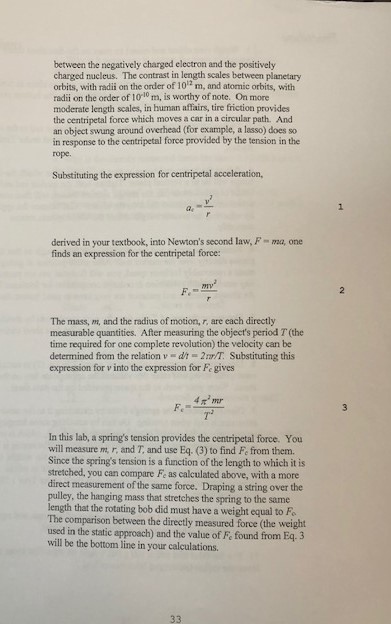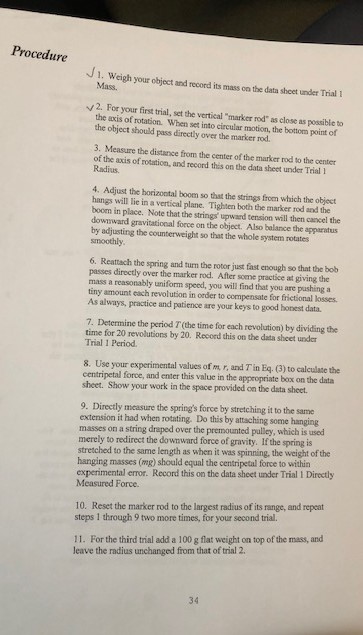
College Physics
11th Edition
ISBN: 9781305952300
Author: Raymond A. Serway, Chris Vuille
Publisher: Cengage Learning
expand_more
expand_more
format_list_bulleted
Concept explainers
Question
Why don't we use Eq. 2 as the operative equation for this lab, instead of Eq. 3?

Transcribed Image Text:between the negatively charged electron and the positively
charged nucleus. The contrast in length scales between planetary
orbits, with radii on the order of 102 m, and atomic orbits, with
radii on the order of 1010 m, is worthy of note. On more
moderate length scales, in human affairs, tire friction provides
the centripetal force which moves a car in a circular path. And
an object swung around overhead (for example, a lasso) does so
in response to the centripetal force provided by the tension in the
rope.
Substituting the expression for centripetal acceleration,
1.
derived in your textbook, into Newton's second law, F-ma, one
finds an expression for the centripetal force:
my
F.
The mass, m, and the radius of motion, r, are each directly
measurable quantities. After measuring the object's period T (the
time required for one complete revolution) the velocity can be
determined from the relation v= di = 2/T. Substituting this
expression for v into the expression for Fe gives
F.
In this lab, a spring's tension provides the centripetal force. You
will measure m, r, and T, and use Eq. (3) to find Fe from them.
Since the spring's tension is a function of the length to which it is
stretched, you can compare Fe as calculated above, with a more
direct measurement of the same force. Draping a string over the
pulley, the hanging mass that stretches the spring to the same
length that the rotating bob did must have a weight equal to Fo
The comparison between the directly measured force (the weight
used in the static approach) and the value of Fe found from Eq. 3
will be the bottom line in your calculations.
33

Transcribed Image Text:Procedure
J1. Weigh your object and record its mass on the data sheet under Trial 1
Mass.
v2. For your first trial, set the vertical "marker rod" as close as possible to
the axis of rotation. When set into circular motion, the bottom point of
the object should pass directly over the marker rod.
3. Measure the distance from the center of the marker rod to the center
of the axis of rotation, and record this on the data sheet under Trial 1
Radius.
4. Adjust the horizontal boom so that the strings from which the object
hangs will lie in a vertical plane. Tighten both the marker rod and the
boom in place. Note that the strings upward tension will then cancel the
downward gravitational force on the object. Also balance the apparatus
by adjusting the counterweight so that the whole system rotates
smoothly.
6. Reattach the spring and turm the rotor just fast enough so that the bob
passes directly over the marker rod. After some practice at giving the
mass a reasonably uniform speed, you will find that you are pushing a
tiny amount each revolution in order to compensate for frictional losses.
As always, practice and patience are your keys to good honest data.
7. Determine the period T(the time for each revolution) by dividing the
time for 20 revolutions by 20. Record this on the data sheet under
Trial 1 Period.
8. Use your experimental values of m r, and Tin Eq. (3) to calculate the
centripetal force, and enter this value in the appropriate box on the data
sheet. Show your work in the space provided on the data sheet.
9. Directly measure the spring's force by stretching it to the same
extension it had when rotating. Do this by attaching some hanging
masses on a string draped over the premounted pulley, which is used
merely to redirect the downward force of gravity. If the spring is
stretched to the same length as when it was spinning, the weight of the
hanging masses (mg) should equal the centripetal force to within
experimental error. Record this on the data sheet under Trial 1 Directly
Measured Force.
10. Reset the marker rod to the largest radius of its range, and repeat
steps 1 through 9 two more times, for your second trial.
11. For the third trial add a 100 g flat weight on top of the mass, and
leave the radius unchanged from that of trial 2.
34
Expert Solution
This question has been solved!
Explore an expertly crafted, step-by-step solution for a thorough understanding of key concepts.
This is a popular solution
Trending nowThis is a popular solution!
Step by stepSolved in 3 steps with 1 images

Knowledge Booster
Learn more about
Need a deep-dive on the concept behind this application? Look no further. Learn more about this topic, physics and related others by exploring similar questions and additional content below.Similar questions
- Which of the following will result in a dimensionless number if x and y have length dimensions, z has mass dimensions, and a has time dimensions?arrow_forwardState how many significant figures are proper in the results of the following calculations. (a) (106.7)(6.5)(46.210)(1.01) (b) (25.8)2 (c) (2.9 ✕ 10−19)(3712)arrow_forwardFive clocks are being tested in a laboratory. Exactly at noon, as determined by the WWV time signal, on successive days of a week the clocks read as in the following table. Rank the five clocks according to their relative value as good timekeepers, best to worst. Give the number of the correct clock in each case. Which clock is (a) the best timekeeper? (b) the second-best timekeeper? (c) the third-best timekeeper? (d) the fourth-best timekeeper? (e) the worst timekeeper? Clock Sun. Mon. Tues Wed. Thurs. Fi. Sat. A. 12:36:40 12:36:56 12:37:12 12:37:27 12:37:44 1237-59 12:38:14 11:59:59 12:00:02 11:59-57 12:00:07 12:00:02 11:59:56 12:00:03 B 15:50:45 15:51:43 15:52-41 15:5339 15:54:37 15:5535 155633 D 12:03:59 12:0252 1201:45 12:00:38 11:59:31 11:58:24 11:57:17 E 12:03:59 12:02:49 12:0154 12:01:52 1201:32 1201:22 1201:12 (a) (b) (c) (d) (e) MacBook Pro G Search or type URL @ 23 $ % & 2 3 4 5 6 7 9 Y P W F G H K C V N * 00arrow_forward
- If massQ/mass A in AQ= 0.271 and mass Q/ mass A in AxQy = 0.362, what is the formula of AxQY?arrow_forwardI1:00:00 PM Problem 3: Suppose the speed of light were only 3000.0 m's. A jet fighter moving toward a target on the ground at 810 m/s shoots bullets, each having a muzzle velocity of 1050 m's. Randomized Variables v-810 m/s v2 1050 m's ed What is the velocity of the bullets relative to the target in km's? Grade Sommary Deductions 0% Potential 100%arrow_forwardA biologist studies a species of bacteria called FAST, her research reveals that FAST bacteria reproduced prodigiously. If a bacteria culture contains 10 FAST bacteria at time t= 0, the number of FAST bacteria in the culture later time 't' is N(t) = 10 +6t +2t2 where 't' is expressed in seconds. How many bacteria occupy the culture a time t = 10s? At t =11s? Calculate how many net bacteria were born during the interval between t=10 and t=11, assume no bacteria died. Now use calculus to find the birth rate of bacteria (rate at which new bacteria get born) at time t=10s, it may help to sketch a rouch graphy of N vs 't'.arrow_forward
- surface, denoted by “g”. In this imaginary experiment, you have measured g three times. The values you obtain are: g1 = 10.2 meters per second squared (m/s2) g2 = 10.4 m/s2 g3 = 10.0 m/s2 To find the Average Value of g, denoted by gav, simple add up the experimental values and divide by the number of experimental values you have: g1 + g2 + g3 10.2 + 10.4 + 10 gav = __________ = ____________ = 10.2 m/s2 . 3 3 Percent Error (PE) To find the Percent Error (PE), you compare the average experimental value to the standard or handbook value of the physical quantity you are measuring. The Standard Value of gravitational acceleration at Earth’s surface , gst, is 9.8 m/s2. Mathematically, PE is defined as: (Average - Standard)…arrow_forwardt Eg=15N and Eo=l", Find Fymn The Smallest Possible Vahek Of minj ty in N Find Fxmar The largest possible Value or Fx, in N maxarrow_forwardI submitted this before but I don't think the answer was 100% correct. Can someone write it out in full on the answers and how they were achieved?arrow_forward
- calculate: (a) the average of fex) = Cos (3x) from II to TT (い th average of f(x) = x² from (-10) to (l0) (c) th average of frxl = 3x from (-3) to (3)arrow_forwardImagine you derive the following expression by analyzing the physics of a particular system: v2=v20+2axv2=v02+2ax. The problem requires solving for xx, and the known values for the system are a=2.55meter/second2a=2.55meter/second2, v0=21.8meter/secondv0=21.8meter/second, and v=0meter/secondv=0meter/second. Perform the next step in the analysis.arrow_forwardIf p/m is .9c,what is v in terms of c?arrow_forward
arrow_back_ios
SEE MORE QUESTIONS
arrow_forward_ios
Recommended textbooks for you
 College PhysicsPhysicsISBN:9781305952300Author:Raymond A. Serway, Chris VuillePublisher:Cengage Learning
College PhysicsPhysicsISBN:9781305952300Author:Raymond A. Serway, Chris VuillePublisher:Cengage Learning University Physics (14th Edition)PhysicsISBN:9780133969290Author:Hugh D. Young, Roger A. FreedmanPublisher:PEARSON
University Physics (14th Edition)PhysicsISBN:9780133969290Author:Hugh D. Young, Roger A. FreedmanPublisher:PEARSON Introduction To Quantum MechanicsPhysicsISBN:9781107189638Author:Griffiths, David J., Schroeter, Darrell F.Publisher:Cambridge University Press
Introduction To Quantum MechanicsPhysicsISBN:9781107189638Author:Griffiths, David J., Schroeter, Darrell F.Publisher:Cambridge University Press Physics for Scientists and EngineersPhysicsISBN:9781337553278Author:Raymond A. Serway, John W. JewettPublisher:Cengage Learning
Physics for Scientists and EngineersPhysicsISBN:9781337553278Author:Raymond A. Serway, John W. JewettPublisher:Cengage Learning Lecture- Tutorials for Introductory AstronomyPhysicsISBN:9780321820464Author:Edward E. Prather, Tim P. Slater, Jeff P. Adams, Gina BrissendenPublisher:Addison-Wesley
Lecture- Tutorials for Introductory AstronomyPhysicsISBN:9780321820464Author:Edward E. Prather, Tim P. Slater, Jeff P. Adams, Gina BrissendenPublisher:Addison-Wesley College Physics: A Strategic Approach (4th Editio...PhysicsISBN:9780134609034Author:Randall D. Knight (Professor Emeritus), Brian Jones, Stuart FieldPublisher:PEARSON
College Physics: A Strategic Approach (4th Editio...PhysicsISBN:9780134609034Author:Randall D. Knight (Professor Emeritus), Brian Jones, Stuart FieldPublisher:PEARSON

College Physics
Physics
ISBN:9781305952300
Author:Raymond A. Serway, Chris Vuille
Publisher:Cengage Learning

University Physics (14th Edition)
Physics
ISBN:9780133969290
Author:Hugh D. Young, Roger A. Freedman
Publisher:PEARSON

Introduction To Quantum Mechanics
Physics
ISBN:9781107189638
Author:Griffiths, David J., Schroeter, Darrell F.
Publisher:Cambridge University Press

Physics for Scientists and Engineers
Physics
ISBN:9781337553278
Author:Raymond A. Serway, John W. Jewett
Publisher:Cengage Learning

Lecture- Tutorials for Introductory Astronomy
Physics
ISBN:9780321820464
Author:Edward E. Prather, Tim P. Slater, Jeff P. Adams, Gina Brissenden
Publisher:Addison-Wesley

College Physics: A Strategic Approach (4th Editio...
Physics
ISBN:9780134609034
Author:Randall D. Knight (Professor Emeritus), Brian Jones, Stuart Field
Publisher:PEARSON